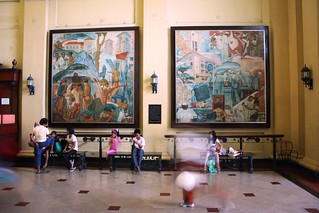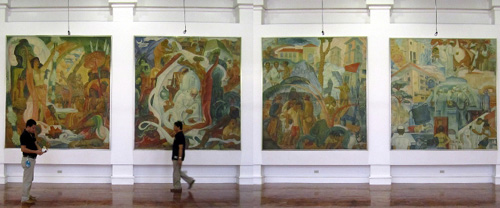Saturday, December 6
I Need A Plastic Bag
Monday, August 11
Ang Tunay na Kuwento ng Hustisya
Thursday, July 24
The Nagtahan Mabini Bridge
 |
| Nagtahan when it was just a pile of wood across the Pasig River. |
It's not so much as a renaming but going back to what it's been officially called decades ago. Apparently, Nagtahan's official name really was "Mabini Bridge," after Marcos's Proclamation of 1967. But we know what happened with that effort. Since it was built in 1945, and rebuilt in the 1960s after a barge rammed into the wooden piles, the bridge on Nagtahan Street has always been called Nagtahan and nothing else.* Presidential proclamations notwithstanding. The Malacanan briefer has this to say: "However, little notice was made of this, and in time the name was forgotten."
And so they try one more time. They even had the Department of Public Works and Highways (DPWH) change all pertinent road signs to read as such.
 |
| This bridge shall now be called Mabini, okay? |
Even in Ingress, the portal that exists is not the bridge per se, but the image of Apolinario Mabini near the top of the bridge's crest, in the general area of where the Mabini Shrine used to be.
 |
| Ohai, Apolinario Mabini! |
*It's the same way with Otis, now known as Paz Guanzon. All the bus signs still say Otis. Even all the establishments along that road refer to it as Otis. Some names have a way of staying "sticky" that even several generations and name changes later, people still know it by the name they have always known.
Thursday, July 17
The game as tourist guidebook
Video games are a spatial medium, filled with words like “map” and “world” and “travel,” but in the physical realm, most games are played indoors by stationary players who sit in basements and living rooms in front of TV screens and computer monitors.
Instead, my favorite way to use Ingress is as tourist guidebook. Beyond that vampire grave in Rhode Island, Ingress also led me to a home on the Upper West Side where Babe Ruth once lived and to the site of Thomas Paine’s death in Greenwich Village...Even so, I discovered plenty of plaques and markers that I didn’t know existed.Because this is also my favorite way of using Ingress. Yes, part of the motivation of visiting as many portals as possible to score the Explorer badges. But I take the exploring seriously (but in a fun, geeky way).
My favorite, mostly accidental finds include the house where the body of Jose Rizal was hidden after his execution, the birthplace marker for a top Filipino poet I stumbled upon as I shuffled from one campus to another, and this fantastic graffiti in a parking lot.
I'm sure there will be more to discover. As soon as I get off my lazy ass and start walking around again.
Sunday, July 13
Pandacan Pho

Sunday, June 22
Sound and the City

What does the city sound like?*
When one thinks of the city, our first thoughts are visual: the skyline of tall buildings, streets and avenues all lit up with neon. There are more elements which make up the urban landscape other than the visual. The sound of traffic, vendors plying their wares, pedestrians hurrying down sidewalks.
Even more curiously, do all cities and urban areas sound the same? How is downtown Manila different from Las Pinas or the fringes of Rizal beyond Ortigas?
Project Bakawan, through its Sound+Movement component, aims to explore this facet of urban life. Project Bakawan is a collaborative art event seeking to increase awareness of current environmental issues. Set on February 2015 in celebration of the National Art's month, it will engage artists in collaboration with the academic community to formulate an acute analysis of our environmental situation and come up with creative responses that will interact with the UP Diliman community.
Curator Dayang Yraola invites Metro Manila's inhabitants (or passers-by--or anyone, really) to contribute an audio recording of people, events or activity, places recorded from anywhere in Metro Manila.
It could be a recording made using professional machines, mobile gadgets (mobile phone, tablet, etc) or any portable recorders; minimum of 30 sec, maximum of 3 minutes; on AMR, MP3 or WAV format; and not more than 2.5MB.
Please follow this format for your contribution:
Filename: Contributor’s name_Content_Date
Additional notes:
Contributor’s name can be a pseudonym
Identify content as: Nature, People, Machines, Structures, Event, Traffic, Others
Composers and sound artists will use the collected sound files for their individual compositions, which is part of a sound installation in U.P. Diliman for Project Bakawan in 2015. Project Contributors will be duly acknowledged.
Please submit audio files to dyraola@gmail.com with subject heading [Bakawan Audio].
*This reminded me of Jodie Foster's character in The Brave One, where she hosts a radio show about the city life. Alas, i never got around to blogging about it.
Sunday, June 8
Botong Francisco at the PGH
This morning, when I checked out information about the murals online, I found out that only 4 of those 5 murals belonged to the original series by Botong Francisco called “The Progress of Medicine in the Philippines." The oil on canvas measured 2.92 meters by 2.76 and
 |
| Photo from Dr. Rico Quimbo's Flickr. |
But all the years of humidity and thick crowds have lead to the paintings being as distressed as the patients there. So in 2007, the National Museum stepped in and took down the panels for restoration, which was funded through a cultural preservation grant from US Ambassador Kristie Kenney. They had a photographer make reproductions and that's what we now see in the PGH lobby. Meanwhile, the original panels are now in the National Museum.
 |
| The restored paintings at the National Museum. Photo by Buen Calubayan from the GMA online article. |
If only four of the panels are by Botong, that means that the fifth panel, the green one, has been added much later. I'm no art expert and couldn't identify paintings by artist on sight, but somehow that last painting was different from the others. It was probably added to "continue" the story of medicine in the Philippines since Botong's ended in the 1950s. The question now is: Who made that last panel?
 |
| Not by Botong: The mysterious fifth panel. |
Of course, if it's only for Ingress portal submission purposes, I doubt that the casual player or NIA Ops would ask for the painter or a portal would be more valuable because it was by a National Artist. But if you're a geek like me, one of the joys of playing Ingress has to do with "accidental" learning about things like history and public art. The itch of not knowing would be there to scratch until you learn for sure who made the darn thing.


